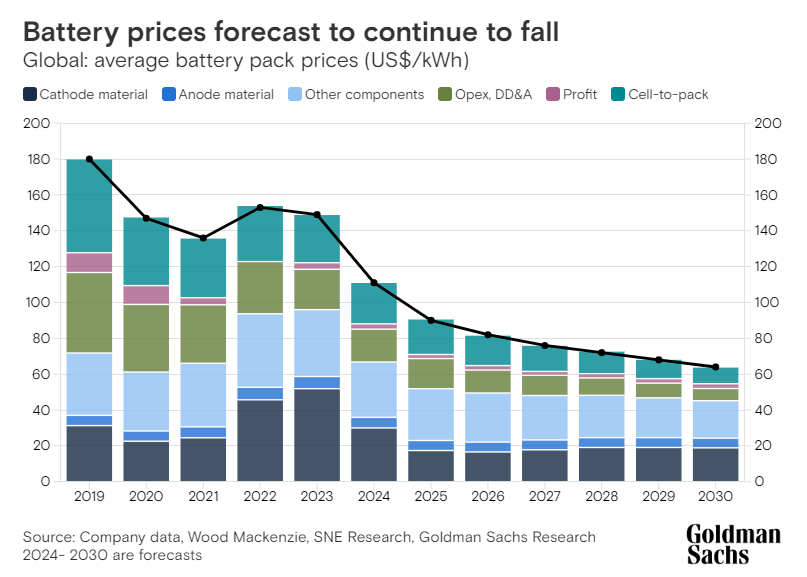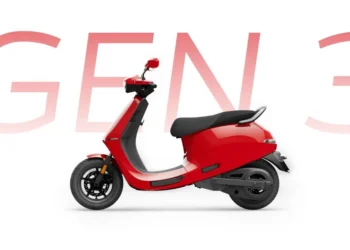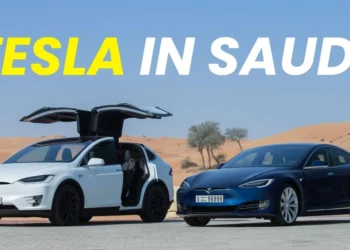As the world shifts towards cleaner energy solutions, electric vehicles (EVs) have gained significant attention for their environmental benefits and cost-saving potential. However, the primary challenge to widespread EV adoption has always been the high upfront cost, particularly driven by the price of batteries. A recent report by Goldman Sachs Research provides optimism for future EV buyers, predicting that the global cost of EV batteries will drop by nearly 50% by 2026. This dramatic cost reduction could make EVs more affordable and push them toward parity with traditional gasoline-powered vehicles.
In this article, we’ll explore why this price drop is expected to happen, the key factors behind it, and how it will impact the EV market in the United States, Canada, and Europe.
Table of Contents
Why Are EV Battery Prices Dropping?
The expected drop in EV battery prices can be attributed to a combination of technological advancements and decreasing costs of raw materials. According to Goldman Sachs Research, global average battery prices fell from $153 per kilowatt-hour (kWh) in 2022 to $149/kWh in 2023, and are expected to continue to decline, potentially reaching $111/kWh by the end of 2024. This downward trend is driven by two major factors: enhanced battery technology and reduced costs of key battery metals.
Technological Innovation Driving Battery Efficiency
One of the most exciting developments in the EV battery sector is technological innovation. Battery makers are introducing new products with 30% higher energy density at a lower cost. This has been made possible by advances in the design of battery cells. Historically, manufacturers packed many small cells into modules, which were then integrated into larger battery packs. Now, manufacturers are shifting to a cell-to-pack approach, eliminating the need for modules. This not only reduces manufacturing costs but also increases the overall energy efficiency of the battery.
Falling Prices of Green Metals
The materials used to manufacture EV batteries, such as lithium, cobalt, and nickel, account for nearly 60% of the battery’s cost. In recent years, the prices of these metals surged due to high demand. However, Goldman Sachs Research predicts that the prices of these metals will continue to decline. This will contribute to over 40% of the total drop in battery prices from now until 2030, further pushing the affordability of EVs.
What Does This Mean for the EV Market?
With EV battery prices expected to fall by nearly 50% by 2026, EVs will become significantly more affordable for consumers. In markets like the United States, Canada, and Europe, where gasoline vehicles dominate the market, this reduction could shift consumer preferences towards electric models. By 2026, Goldman Sachs Research predicts that the total cost of ownership (TCO) for an electric vehicle will achieve parity with traditional gasoline-powered cars, without relying on government subsidies or tax incentives.
The Total Cost of Ownership Parity
One of the key factors influencing consumer purchasing decisions is the total cost of ownership (TCO), which includes both upfront purchase price and long-term expenses like fuel, maintenance, and depreciation. Currently, the higher upfront cost of EVs is a significant barrier for many consumers. However, as battery prices decline, the TCO of EVs will become competitive with gasoline vehicles. This shift is expected to happen as early as 2026, according to Goldman Sachs Research.
Key Battery Technologies in the EV Industry
Two battery types currently dominate the EV market: nickel-based lithium batteries and lithium iron phosphate (LFP) batteries. While nickel-based batteries are favored for their higher energy density, LFP batteries are becoming increasingly popular due to their cost advantages and improved safety. Goldman Sachs Research predicts that LFP batteries will continue to capture a larger share of the market, reaching around 45% by 2025.
Additionally, while sodium-ion and solid-state batteries hold promise for the future, these technologies are still in early development stages. Solid-state batteries, for example, could offer substantial improvements in safety and energy density but are facing delays in mass production.
The Competitive Advantage of Lithium-Based Chemistries
Despite the potential of new battery technologies, lithium-based chemistries are expected to remain dominant for the foreseeable future. Companies that have been producing lithium-based batteries for over two decades continue to lead the market and are ramping up their research and development efforts. This makes it challenging for newer entrants to compete, especially during periods of market downturns.
The Path to Consumer-Led EV Adoption
As battery prices drop, Goldman Sachs Research suggests that EV adoption in the U.S., Canada, and Europe will increasingly be driven by consumer demand rather than regulatory mandates. While government incentives have played a significant role in driving EV adoption thus far, the cost-effectiveness of EVs will soon make them more appealing to the average consumer. Goldman Sachs Research expects that by 2026, a consumer-led adoption phase will begin, driven by economic factors rather than government subsidies.
Impact of Resale Values on EV Adoption
A challenge that currently affects the resale value of EVs is consumer expectations of falling prices. As buyers anticipate that EV prices will continue to drop, they are hesitant to purchase vehicles at higher prices, leading to depreciation and lower resale values. However, as battery prices continue to fall, the total cost of ownership for EVs will become more favorable, which should help stabilize resale values and boost consumer confidence.
What to Expect in 2026 and Beyond

Goldman Sachs Research is confident that 2026 will be the turning point for consumer-led adoption of EVs. By this time, the economics of owning an EV will become compelling for most buyers. With the combination of lower battery prices, favorable fuel savings, and potentially lower maintenance costs, EVs will offer a complete package that matches, or even exceeds, the value of gasoline vehicles.
Conclusion: A Brighter Future for EVs
Goldman Sachs Research’s prediction of a near 50% drop in EV battery prices by 2026 marks a pivotal moment in the journey toward widespread EV adoption. As battery prices continue to fall, consumers in the US, Canada, and Europe can expect to see electric vehicles become more affordable, accessible, and economically viable. This change will not only accelerate the shift towards sustainable mobility but also reshape the automotive market in the coming years.
Read also: Tesla Cybercab: The Future of Autonomous Driving, Click here.
FAQs
1: Why are EV batteries becoming cheaper?
EV batteries are becoming cheaper due to advances in battery design (cell-to-pack technology) and a decrease in the price of key battery metals like lithium and cobalt.
2: When will EVs become as affordable as gasoline cars?
According to Goldman Sachs Research, EVs could achieve cost parity with gasoline vehicles as early as 2026, based on the reduction in battery prices and lower total cost of ownership.
3: What are the main types of batteries used in EVs today?
The main types of batteries used in EVs today are nickel-based lithium batteries and lithium iron phosphate (LFP) batteries.
4: What is the expected market share of LFP batteries by 2025?
Goldman Sachs Research predicts that LFP batteries will hold around 45% of the market by 2025.
5: How will the decline in battery prices affect the demand for EVs?
As battery prices continue to fall, the total cost of ownership for EVs will become more competitive with gasoline cars, driving a consumer-led adoption phase in markets like the US, Canada, and Europe by 2026.







